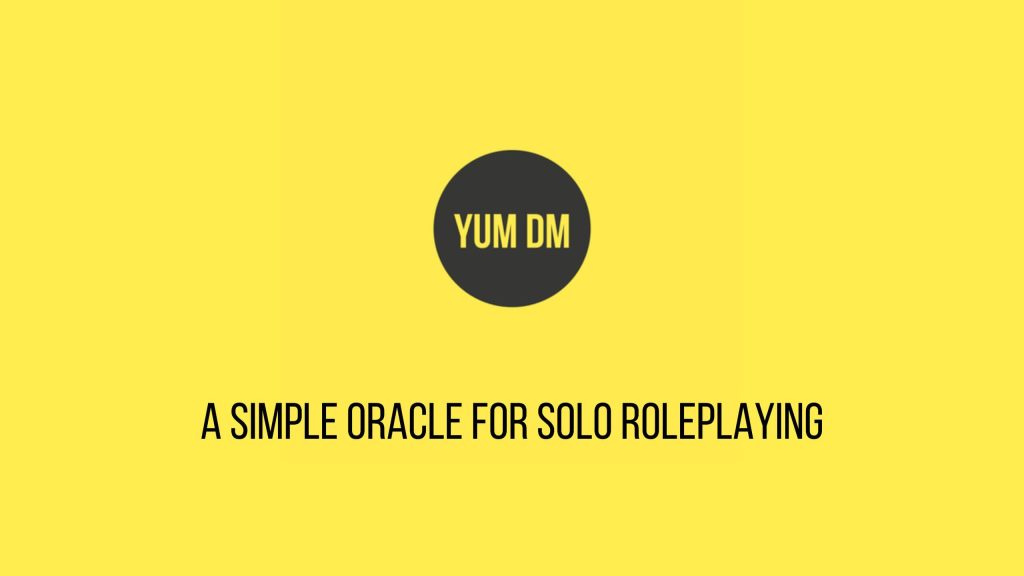
Oracles are an essential part of solo roleplaying.
They fill in the role of GM to a large extent, throwing up additions to the evolving story as we probe and ask questions of the world and the events within.
There are a few well-known oracles that take up whole books, filled with tables and outcomes, but what I want to promote here is a very easy to use, and fast, oracle which is not only versatile, but also completely free.
It involves a simple D6.
The D6 Oracle
I have mentioned this method previously, but it’s such a simple and universally easy oracle to use, I felt it deserved its own blog post. And I have included some simple variations you can use with it as well.
The D6 oracle is as simple as rolling a single six-sided die, and consulting the following table (something that becomes so second nature after a while).
1. No, and
2. No
3. No, but
4. Yes, but
5. Yes
6. Yes, and
But what do these results actually mean?
They answer any question you have.
Before you roll the oracle die however, you need to ask it a specific yes/no question. That is, a question that can be answered with a ‘yes’ or a ‘no’.
I find it best to say the question aloud, or at least have it firmly in your head, before rolling the die.
The Meanings
No, And
‘No, and’ means the answer is a no, or negative, but something else happens, or is entwined in the answer somehow. This could make the no result even worse than a straight no.
No
‘No’ means a solid no, or negative.
No, But
‘No, but’ means the answer is a no, or negative, but there is a complication of some sort. It’s a no, however, something else is happening that may lessen the impact of the no result.
Yes, But
‘Yes, but’ is the same as ‘no, but’ but in the positive.
Yes
‘Yes’ is a solid yes, or positive result.
Yes, And
‘Yes, and’ means the answer is a yes, or positive, but something else happens or is entwined in the answer somehow. This may make the yes result even better than a straight yes.
Once you have your result, you will need to interpret it.
Interpreting the Result
Depending what you asked and the result of the die roll, will depend on how long you take to decide on the actual outcome.
A result of Yes or No is usually pretty straight forward.
Let’s say you were after a particular NPC, and you have been told that that NPC often visits a tavern in town. You visit said tavern and then ask a question to see if the NPC is currently in the tavern.
If you asked if the NPC you were after was in the bar, and the result came up Yes, then he was there. If the result was No, then he wasn’t there.
The ‘Buts’ and ‘Ands’ can take a little longer (relatively speaking).
A great deal of the time, when I roll one of these ‘but’ or ‘and’, I simply use the first thing that pops into my mind.
Continuing our bar example, if I rolled a ‘Yes, but’ result, the first thing I thought was that he was there with other people with him. This could indeed complicate matters.
Q: Is Dak in this tavern?
A: Yes, but… he is sitting at a table with [rolls a D4] 3 other people.
If I rolled, Yes, and, the first thing I think of is he hasn’t noticed you.
Q: Is Dak in this tavern?
A: Yes, and… he didn’t notice you arrived.
If I roll, ‘No, but’, the first thing I think of is the barkeep knows where he is.
Q: Is Dak in this tavern?
A: No, but… the barkeep knows where he has gone.
If I rolled, ‘No, and’, the first thing that comes to mind is that he has never been here.
Q: Is Dak in this tavern?
A: No, and… he has never been here. A false lead.
If you want to see an extension of this example (and download the word tables I use) check out my post on using various word tables in conjunction with this simple D6 Oracle.
And, if you want to create your own word tables, I have a post on how to do just that.
If you decide to ask the barkeep where he is, you could use a reaction roll combined with an Oracle-like die to find out why he reacts that way.
Benefits
Benefits of this oracle is obvious: it’s simple and it’s quick.
You can know the answer to your question almost immediately without bothering with books and tables.
It can also be used on-the-go, almost anywhere you are, as long as you have a D6. A perfect part of your solo kit.
Limitation
The obvious limitation is that it only answers yes/no questions. You need to frame your questions so they can be answered with a yes or a no.
This can be off-set however, if you use a random word table.
In fact, all I use in my solo session is the D6 oracle + a simple word table.
This is enough for me to work out what is going on, and gives me enough prompts to spark my imagination and creativity.
Tweaking the D6 Oracle
Sometimes an event is more probable than not, and the reverse can also be true. In these instances I usually add a +/- 1 (or rarely, a +/-2) to the roll.
This weighting the die roll means that some results are not achievable, while others become more likely.
In the tavern example above, if I knew this tavern was definitely a hangout of Dak, then I could say I will add one to the result. This means the chance of a ‘no’ coming up is decreased, while the chance of a ‘yes’ is increased.
Another way to favour one result or the other, which I found in MUNE when researching this post, was to use the advantage/disadvantage system for the oracle die.
You do this by rolling 2D6 and using the higher of the two if the answer is more likely a ‘yes’, and the lower of the two results if the answer is more likely a ‘no’.
D6 Oracle Variants
Several variants or additions to this oracle system are below.
Category Die
Roll 2D6 of different colours: one being the standard oracle die, and the other being a category die.
The category die shows what type of result it is related to:
1. Foe-related consequences
2. Resource-related consequences
3. Environment-related consequences
4. Character-related consequences
5. Quest-related consequences
6. Story progression
This allows you to zero in on the type of result you get.
Returning once again to our tavern example, my PCs go to the tavern that Dak frequents as his local, I roll 2D6 (one black for the oracle, the other blue, for the type of consequence), adding 1 to the result of the oracle die due to the likelihood he is here. I roll a 3 (+1) on the oracle and a 3 on the consequence die.
Looking at the tables above, it is a ‘yes, but’, which came about due to an environmental-related consequence. I could interpret this as: He is here, but is hidden in a darkened booth (make a Search/Perception check to spot him).
Wild Twist
You could also roll 2D6 (of different colours): one the oracle die and the other a “wild die”.
If the wild die ever comes up as a natural 6, this creates a twist in the result. You could then consult a wild table of your own making, or just use a word list and interpret that to add a wild twist to the oracle result.
Let me know in the comments below if you have any alternate ways to use a D6 oracle.
Sliding Scale
Another way to use the oracle die is not yes/no, but to use it as a sliding scale. Each number represents an escalation, moving from “disastrous” on a roll of 1, to “extraordinary positive” on a roll of a 6, as shown below:
1. Disastrous consequences
2. Negative consequences
3. Slight negative consequences
4. Slight positive consequences
5. Positive consequences
6. Extraordinary positive consequences
This could be used in certain circumstances instead of an answer to a yes/no question. Or even in conjunction with a regular oracle die.
For example, in our tavern example from above, the question is asked and answered as ‘yes, but’ and Dak is indeed in the tavern in a shadowed booth. You could then roll a sliding scale die to see how this scene may play out.
If a 1 comes up, finding Dak would have “disastrous consequences” for the PCs. You could interpret this as the PCs find Dak just as another party finds him also – a fight may ensue as the two parties vie for Dak.
If a 4 is rolled, this encounter could be “slightly positive” for the PCs. Maybe, as the PCs enter, Dak sees them and surrenders to them, letting them know he is willing to cooperate (but also knowing another party is after him).
Final Thoughts
As you can see, you can use a simple, single-die, oracle with great effect for your solo roleplay sessions. And, if needed, you can mix it up a little to create an even better system for yourself.
Over to You
Let me know what you use as your oracle in the comments below – I would be keen to find out.
While You’re Here…
Since 2021 I have been publishing d12 Monthly, a monthly zine, which has a ton of articles for any edition of Dungeons and Dragons.
Printed copies are available in my store. The PDF is available on DriveThruRPG and you can get both, plus support my work, via my Patreon.
I will also be releasing some more products in the near future.
Feel free to reach out to me on Twitter or my contact page any time.

I loved this write-up. I think this will give me a much more fun way to do world building and character driven storytelling in my prep as a GM when I have longer breaks between sessions. Thanks for sharing this! Can’t wait to test out the D6 oracle method.
Thanks heaps! I am very happy it helps you out. Let me know how it all goes – I am about to start a new solo campaign myself, so am trying to put together some blog posts to show others how I handle it.